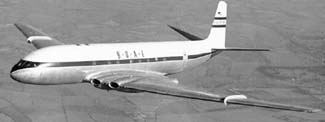Fatigue: The progressive deterioration of the strength of a material or structural component during service such that failure can occur at much lower stress levels than the ultimate stress of the material. Fatigue is a dynamic phenomenon that initiates small (micro) cracks in the material or component and causes them to grow into large (macro) cracks. These cracks if not detected can lead to catastrophic failure.
Fatigue is classified into five types:
- Cyclic Fatigue - caused by repeated loading and unloading of the material or structural component.
- Corrosion Fatigue - cyclic fatigue accelerated by surface corrosion of the material penetrating inwards.
- Fretting Fatigue - caused by small scale rubbing and abrasion of adjacent parts.
- Thermal Fatigue - caused by stress fluctuations induced by thermal expansions and contractions.
- Acoustic Fatigue - also known as sonic fatigue, is caused by fluctuations due to vibrations excited by, for example, jet or propeller noise.
The fatigue strength of a material is the maximum stress that can be repeated for a specified number of loading cycles without producing failure of the structural member.
Fatigue Analysis: We are interested in two primary things in understanding fatigue;
-
We're interested in conditions required to initiate a crack.
Fatigue crack initiation is normally associated with the endurance limit of a material and the stress concentration.
-
We're also interested in the conditions required to propagate a crack once it is formed.
Fatigue crack propagation is associated with the fracture toughness and crack growth characteristics of a material.
The stress field near a fatigue crack tip can be divided into three types:
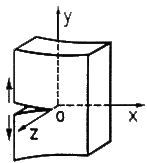 |
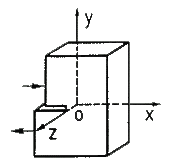 |
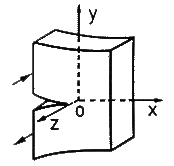 |
| (a) | (b) | (c) |
| Load applied in y direction | Load applied in x direction | Load applied in z direction |
Shown above are the three basic modes of crack extension. (a) Opening mode, I, (b) Sliding mode, II, (c) Tearing (or anti-plane) mode, III.
Types of Fatigue Testing:
- Material crystal and test specimen testing are the material engineer's concern.
- Complete structural member testing is the structural engineer's concern.
|
S-N Diagram: Cyclic fatigue of a material or structural component is determined based on the plot of stress (S) and the number of loading cycles (N) that results in failure. The scatter plot indicates how fast fatigue failure occurs as the number of cycles and applied loads are increased. The fatigue failure depends on the loading application. For example, if the test article is loaded in tension to some specific value (e.g., 6000 psi) and then unloaded back to zero in each cycle, its N will be different from the case when the test article is loaded in tension to 3000 psi and then compressed to -3000 psi in each cycle. We find that the number of cycles in the latter case is much higher than that in the former. A comparison of fatigue characteristics of 2024 and 7075 alumnium alloys can be seen in the figure below. In each case a curve that represents 90% probability of failure is shown. |
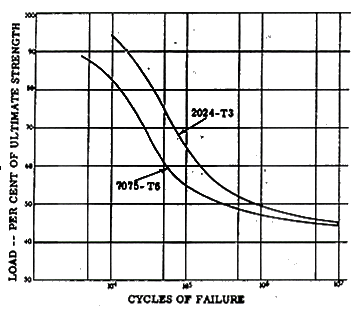 |
|
Historical Perspective: Fatigue failure was virtually an unknown phenomenon till the middle of the 20th century. Up to that time all structural components that underwent cyclic loading were designed to the static strength of the material with some factor of safety. Fatigue and associated structural failure came to light in the early 1950's with the mysterious in air explosion of first transsonic airliner, the DeHavilland Comet shown in the figure below. The introduction of high strength 7000 series aluminum alloys was very appealing to the aircraft industry which sought to use them in most of the airframe structure. Unknown to the designers and engineers at the time was the poor fatigue characteristics o this alloy. The repeated presurization of the fuselage led to the initiation of small cracks around the window opening which ultimately led to the catastrophic failure of the structure. The two Comets that were lost were found to be, after extensive analysis, particularly prone to crack development and propagation. After much research, new additions to the 7000 series have made them much more fatigue resistant. New aluminum alloys like PM (powder metallurgy) and aluminum-lithium (10 % lighter and 10 % stronger than conventional aluminum alloys, with superior fatigue resistance) are being developed and used in more and more applications. |
|
